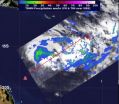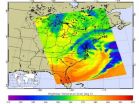The future of ion traps
Technology will continue to be a leader in the development of quantum computing architectures
2013-03-08
(Press-News.org) Recently Science Magazine invited JQI fellow Chris Monroe and Duke Professor Jungsang Kim to speculate on ion trap technology as a scalable option for quantum information processing. The article is highlighted on the cover of this week's issue, which is dedicated to quantum information. The cover portrays a photograph of a surface trap that was fabricated by Sandia National Labs and used to trap ions at JQI and Duke, among other laboratories.
Trapped atomic ions are a promising architecture that satisfies many of the critical requirements for constructing a quantum computer. At the heart of quantum computers are qubits, systems maintained in two or more quantum states simultaneously. Here, the qubits are manifested in the internal energy levels of the ions, and are manipulated through laser and microwave radiation. These technologies are a key factor in the success of atomic ions: scientists can set the frequency of the radiation to match that of the ion's energy level spacings with extreme precision.
The qubits have long coherence time -- meaning they can be placed in quantum states and remain that way long enough to perform calculations. The qubit's states are not sensitive to ambient disturbances like magnetic fields, giving them inherent protection from the destructive environment.
Additionally, the ions are in a vacuum of lower than 10-11 torr. This is about 100 trillion times lower than atmospheric pressure. To visualize this daunting number, imagine light particles like hydrogen or nitrogen in a vacuum chamber. After special pumps remove most of the air, there are so few molecules left that before one molecule will collide with another, it will typically travel a distance comparable to the circumference of the earth. At atmospheric pressure, even though we can't see them with our eyes, there are so many molecules floating about that they only travel about a hundredth the width of a human hair before they bump into a neighboring particle.
Scientists want to go even further. Using cryogenics (cooling to near absolute zero temperature), they expect to push a few more factors of ten lower in pressure. Cooling the system is effective because it makes the molecules stick to the walls, thus removing them from the region where the ions rest.
Ion traps themselves were invented more than a half-century ago, but researchers have implemented new technologies in order to store large ion crystals and shuttle ions around as quantum operations are executed. Professionally micro-fabricated devices, like the one shown on the cover, resemble traditional computer components. Some researchers are also integrating optics on-board the traps. Although quantum logic operations in such chip traps remain elusive, the obstacles are not prohibitive. In the US, researchers at institutions such as NIST (Boulder), Sandia National Labs, Georgia Tech Research Institute, JQI, Duke, MIT, and others are now, often collaboratively, fabricating and testing these technologies.
Monroe and Kim are part of a larger collaboration called MUSIQC, which stands for Modular Universal Scalable Ion-trap Quantum Computer, and is supported by the Intelligence Advance Research Projects Activity (IARPA). This program focuses on building the components necessary for a practical quantum computer. The effort involves national labs, universities, and even private small businesses.
INFORMATION: END
ELSE PRESS RELEASES FROM THIS DATE:
2013-03-08
NASA's Tropical Rainfall Measuring Mission satellite noticed areas of heavy rainfall in low pressure System 92P hours before it became the nineteenth tropical cyclone of the Southern Pacific Ocean.
NASA's TRMM satellite captured a look at the rainfall rates within low pressure System 92P on March 7 at 0023 UTC (March 6 at 7:23 p.m. EST), just hours before it became Tropical Cyclone 19P (TC 19P). TRMM data indicated that heavy rain was falling at a rate of 2 inches/50 mm per hour around the center of circulation, and that some of the thunderstorms were powerful as they ...
2013-03-08
This press release is available in French.
Montreal, March 7, 2013 – Just hours after the tragic shooting of 27 victims at Sandy Hook Elementary School, Twitter was overloaded with messages slamming reporters for interviewing children involved in the tragedy. While some of the journalists probably knew better but wanted the story at all costs, others were rookie reporters facing ethical decisions for the first time and unaware of the impact these interviews might have on the young survivors.
Past studies have documented that new journalists can cause a number of ...
2013-03-08
A team of astronomers using NASA's Hubble Space Telescope has taken an important step closer to finding the birth certificate of a star that's been around for a very long time.
"We have found that this is the oldest known star with a well-determined age," said Howard Bond of Pennsylvania State University in University Park, Pa., and the Space Telescope Science Institute in Baltimore, Md.
The star could be as old as 14.5 billion years (plus or minus 0.8 billion years), which at first glance would make it older than the universe's calculated age of about 13.8 billion ...
2013-03-08
Ann Arbor, Mich. — Primary care practices around the country are being encouraged and even paid to become "medical homes," but small practices might be at a significant disadvantage in this race to improve health care for children, according to a new study by child health experts at C.S. Mott Children's Hospital.
Efforts around the country to improve health care for children have increasingly focused on the medical home as a model to make primary care practices more accessible, comprehensive, and focused on quality improvement. Since 2008, practices could become officially ...
2013-03-08
What can green algae do for science if they weren't, well, green?
That's the question biologists at UC San Diego sought to answer when they engineered a green alga used commonly in laboratories, Chlamydomonas reinhardtii, into a rainbow of different colors by producing six different colored fluorescent proteins in the algae cells.
While fluorescent green, red, blue and yellow may be all the rage this year for running shoes and other kinds of sporting gear, fluorescent algae hasn't been a style trend yet in scientific laboratories. But in announcing their achievement in ...
2013-03-08
WACO, Texas (March 7, 2013) - A genetic analysis by Baylor University biologists suggests that the stocking of Florida bass in Texas reservoirs impacts bass populations far beyond the actual stocking location.
The native largemouth bass has a long and nearly continuous stocking history in Texas. However, the Florida bass is widely considered a better sport fish because it grows to a greater size. Subsequently, stocking efforts in Texas reservoirs have transitioned from largemouth bass to Florida bass.
The Baylor researchers analyzed the genetic composition of 69 largemouth ...
2013-03-08
Malaria, the leading cause of death among children in Africa, could be eliminated if three-fourths of the population used insecticide-treated bed nets, according to a new study from the National Institute for Mathematical and Biological Synthesis (NIMBioS).
The study, which uses a mathematical model, found that use of insecticide-treated bed nets or ITNs positively affected the infection's reproduction number, or R, which is the primary epidemiological number used to determine the degree which a disease can spread through a population. The model concludes that if 75 percent ...
2013-03-08
VIDEO:
This animation of NOAA GOES-13 satellite imagery from March 5-7, 2013, shows the progression of a cold front from the west associated with a low pressure system that brought snow...
Click here for more information.
The merging of two low pressure areas into a large Nor'easter on March 6 brought winter weather advisories and warnings to the Mid-Atlantic. NASA's Aqua satellite captured an infrared and near infrared image of the storm's power, and NASA created an animation ...
2013-03-08
The star Eta Carinae is ready to blow. 170 years ago, this 100-solar-mass object belched out several suns' worth of gas in an eruption that made it the second-brightest star after Sirius. That was just a precursor to the main event, since it will eventually go supernova.
Supernova explosions of massive stars are common in spiral galaxies like the Milky Way, where new stars are forming all the time. They are almost never seen in elliptical galaxies where star formation has nearly ceased. As a result, astronomers were surprised to find a young-looking supernova in an old ...
2013-03-08
With data from 73 ice and sediment core monitoring sites around the world, scientists have reconstructed Earth's temperature history back to the end of the last Ice Age.
The analysis reveals that the planet today is warmer than it's been during 70 to 80 percent of the last 11,300 years.
Results of the study, by researchers at Oregon State University (OSU) and Harvard University, are published this week in a paper in the journal Science.
Lead paper author Shaun Marcott of OSU says that previous research on past global temperature change has largely focused on the ...
LAST 30 PRESS RELEASES:
[Press-News.org] The future of ion traps
Technology will continue to be a leader in the development of quantum computing architectures



